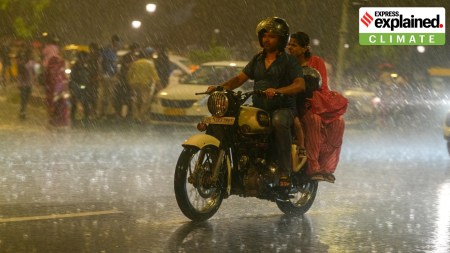EXPLAINED CLIMATE NEWS - Page 3
Climate change, inadequate warning systems & hilly terrain: What led to the deadly floods in TexasSubscriber Only
The latest flash floods have been far more deadly than the ones seen in recent decades. That is because of two primary reasons, the warming climate and inadequate warning systems.
What is behind the record-breaking heat in KashmirSubscriber Only
After the hottest June in nearly 50 years in Kashmir, both Srinagar and the resort town of Pahalgam recently witnessed record-high temperatures. What is causing this?
How extreme heat has become Europe’s new climate realitySubscriber Only
Europe is the fastest-warming continent as it is witnessing an average temperature rise of around 0.5 degrees Celsius per decade compared to 0.2 degrees Celsius globally.
What caused early national coverage by monsoon this year?Subscriber Only
This year, the monsoon onset was early as well. It arrived in Kerala on May 24, eight days before the usual date schedule of June 1
Over 30 killed in 2 days: What makes Pakistan highly vulnerable to climate change, what is worsening mattersSubscriber Only
Pakistan's geography plays a part in making it vulnerable to climate change. However, there are other factors at play. We explain.
Bonn Climate Change Conference begins: Everything you need to know
The Bonn Climate Change Conference is an annual mid-year meeting that takes place under the United Nations Framework Convention on Climate Change (UNFCCC) — an international agreement, signed in 1992, that has provided a basis for climate negotiations.
How extreme heat is affecting IndiaSubscriber Only
People living in Delhi, Maharashtra, Goa, Kerala, Gujarat, Rajasthan, Tamil Nadu, Andhra Pradesh, Madhya Pradesh, and Uttar Pradesh face the highest risk from heat in the country, according to a new study
Why have rains subsided in Mumbai after a historic early onset?Subscriber Only
The IMD said Mumbai and its neighbouring districts will continue to experience only light showers for the next five days. Just a week ago, Mumbai witnessed its earliest onset of monsoon in decades.
How the Madden-Julian Oscillation helped trigger the early onset of the monsoon
The phenomenon takes its name from the two scientists who identified it in 1971 — Roland Madden and Paul Julian, who then worked at the National Centre for Atmospheric Research in Boulder, Colorado.
What is a bow echo, how did it signal Delhi’s fierce storm?Subscriber Only
A bow echo is a radar signature of a high wind-driven storm front which forms due to strong winds pushing the centre of the storm line forward, indicating intense straight-line winds.
As early monsoon hits Mumbai, the key factor: Madden-Julian OscillationSubscriber Only
Mumbai Monsoon 2025: This is the earliest that the monsoon has arrived in Mumbai. The normal date of monsoon onset in Mumbai is June 11. Here are the factors that led to this.
What caused an ‘early’ monsoon onset in India this year?Subscriber Only
Monsoon Update in India: Multiple, large-scale atmosphere-oceanic and local factors developed and favoured the early monsoon onset this year. Here is what to know.
Tyre particles: How EVs are a climate solution with pollution problemSubscriber Only
The study, published in Soft Matter, a journal of the Royal Society of Chemistry, has shown that EVs, on account of their greater weight, experience higher wear and tear in their tyres compared to conventional vehicles, and release substantially larger numbers of small plastic particles in the atmosphere.
Wetter & not that hot: Why is summer of 2025 atypical so far?Subscriber Only
IMD summer weather report, India weather trends May 2025: A cooler-than-usual summer over large geographical areas of the country has contributed to keeping all-India average temperatures within the normal range.
How Argentina’s most famous glacier, once unusually stable, is now crumblingSubscriber Only
For several decades the Perito Moreno glacier was unusually stable, unlike other glaciers across the world, amid soaring global temperatures. But this changed around 2020.
Storm in Delhi, floods in hill states: Impact of climate change-induced changing patterns of Western DisturbancesSubscriber Only
Delhi and its surrounding areas woke up to heavy rainfall and strong winds on Friday. They brought relief amid the May heat, but what exactly triggered these unseasonal rains? Does climate change have a role to play?
How draft Greenhouse Gases Emissions Intensity Targets aim to help India meet climate goalsSubscriber Only
What do the Greenhouse Gases Emissions Intensity (GEI) Target Rules, 2025, say? Why are they needed, and how will these targets help India’s carbon credit trading market?
The history and evolution of monsoon forecasting in IndiaSubscriber Only
The efforts to make accurate forecasts of the southwest monsoon go back to 1870s. It is through a long process of trial and error that the IMD has improved its predictions. But there is scope to do better.
Why Europe is warming faster: Causes many, including its cleaner airSubscriber Only
Europe has warmed about twice as much as the world as a whole, the 2024 European State of the Climate Report said. Here are the causes and impact of this.
Ramban rain causes destruction: Understanding the weather events affecting the regionSubscriber Only
Ramban rain destruction: While episodes of heavy rain are often termed “cloudburst”, a cloudburst has a fixed technical definition, and is more common in hilly areas. We explain why.
Explained: World’s first market for particulate emissions trading in Gujarat, how it workedSubscriber Only
The study builds on the idea of emissions trading, which has been in operation in Europe since 2005 and in China since 2021, and has at times been criticised.
With a very hot summer ahead, how prepared is India?Subscriber Only
IMD has said this summer will be extremely warm, and have above-normal heatwave days, which can have severe impacts. Although several states have heat action plans, their implementation is inadequate
Green Credit Programme: What the scheme entails, criticisms against itSubscriber Only
The Centre’s ambitious scheme seeks to invite voluntary participation in sectors ranging from plantations to water conservation in exchange of tradable credits
How global warming is affecting the world’s mountain rangesSubscriber Only
Mountains, which cover 33 million sq km of the Earth’s surface, are crucial for sustaining life on the planet. For instance, around 2 billion people downstream depend on mountains for freshwater resources from melting glaciers
As Donald Trump rolls back paper straws, are plastic straws really so bad for the environment?Subscriber Only
The US government has scrapped paper straws to go back to plastic. So why are the plastic variety restricted in many countries around the world in the first place?
BEST OF EXPRESS



















































